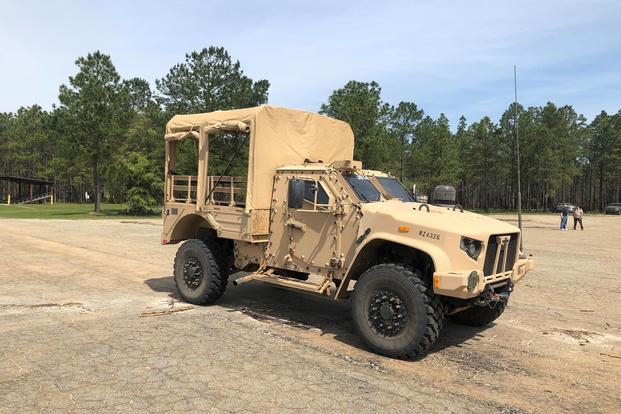Soldiers from the 3rd Infantry Division recently had the chance to test some improved features the Army has designed for the Joint Light Tactical Vehicle.
The 1st Armored Brigade Combat Team soldiers spent several days in late April taking part in an evaluation to gather feedback on new features designed to increase soldier safety and situational awareness on the new vehicle, according to a recent Army news release. The JLTV was designed to replace a large portion of the service's Humvee fleet.
The Fiscal 2018 Annual Report from the Defense Department's Director for Operational Test and Evaluation stated that the JLTV suffered from poor crew visibility due to blind spots around the vehicle, excessive noise signature and other shortcomings that could hinder combat effectiveness.
The Army recently added improvements to some JLTVs that include "roughly 250% larger rear windows," and a forward-facing camera to make it easier for soldiers to see what's going on outside the vehicle, according to the release.
Related content:
- Army's Brand-New Combat Vehicle Was Designed for the Last War, Esper Says
- Army to Cut JLTV Buy to Pay for Future Systems
- Blind Spots and Loud Noises: Report Finds Problems With New JLTVs
The service also added a muffler to reduce engine noise and make it easier for the crew to communicate; a troop seat kit; and a trailer to increase the cargo-carrying capacity, the release states.
The 1st ABCT troops have fielded more than 320 JLTVs since January. During the test, soldiers spent a day going through convoy operations in the vehicles without the upgrades and then went through the same lanes in vehicles with the upgraded features.
Pfc. Allan Muraira said the larger windows are crucial to being able to scan for improvised explosive devices or other hazards during tactical halts, the release states.
"My eyes didn't hurt as much because I wasn't straining," Muraira said in the release. "It's hard to see out the smaller window."
Drivers and truck commanders said they appreciated the front-facing camera.
Sgt. Daniel Kledzinski said they took the trucks to the wash racks on the first day of the testing and were able to drive up the ramps with better visibility using the camera,
"It made a world of difference because, with the camera, you can actually see what you are about to drive over," he said in the release.
Kledzinski added that the noise-dampening muffler reduced fatigue.
The service has decided to upgrade all JLTVs with the larger windows, camera and mufflers, but a new troop seat kit and trailer are still in the test phase, Maj. Erika Hanson, assistant production manager for JLTV Systems Integration, said in the release.
The Army had initially planned to buy about 49,099 JLTVs, but leaders announced in March that the service would cut funding to the program in its proposed fiscal 2020 budget request, to free up more money for future modernization projects.
Army Secretary Mark Esper said recently that it may take up to 18 months before the service knows how many JLTVs it will need for the future battlefield.
-- Matthew Cox can be reached at matthew.cox@military.com.














